Augmented Reality in Automotive Industry
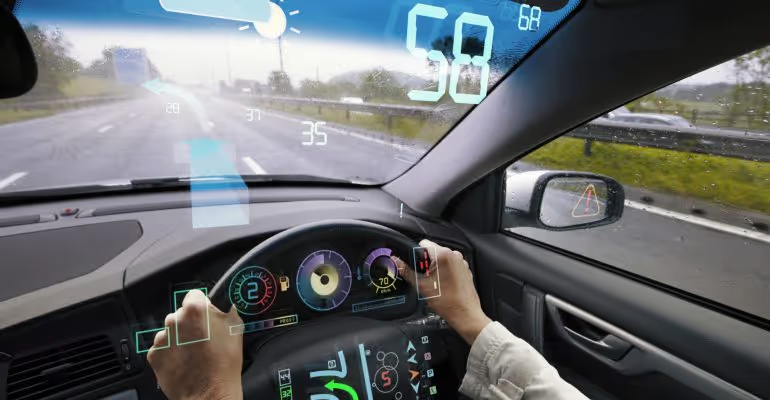
Augmented reality in automotive industry is revolutionizing how cars are designed, manufactured, sold, and driven. From AR-powered heads-up displays that enhance driver safety, to immersive AR tools in design, training, and customer experience, AR helps automakers reduce costs, accelerate prototyping, and improve engagement. In the U.S., leading manufacturers are integrating AR across assembly lines, vehicle maintenance, and showroom experiences, making it a cornerstone of the future automotive ecosystem.
In this article, we’ll explore how augmented reality is shaping the future of car dealerships and transforming the U.S. automobile industry.
Augmented reality car dealerships in the automobile industry are revolutionizing car buying by enabling customers to virtually explore, customize, and test-drive vehicles from any location. By integrating AR into showrooms and digital platforms, dealerships enhance customer engagement, reduce decision-making time, and offer immersive experiences that increase sales. For automakers and dealers, AR creates a competitive edge by blending digital convenience with in-person automotive retail.
Augmented reality is revolutionizing the automotive industry by enhancing design, manufacturing, sales, and training through immersive visual overlays, creating a competitive edge.
What Are Augmented Reality Car Dealerships?
Look at the car world today. It's a battleground of new ideas, isn't it? Every big company, from old giants to quick new businesses, is fighting for market share, customer loyalty, and a piece of the future. The challenge is not just making great cars anymore. It's about building them faster, smarter, and with an experience that truly grabs people. The market has many choices, and consumers demand more than just transportation – they want an experience, a real connection.
This is exactly why technologies like augmented reality in the automotive industry are no longer a luxury, but a strategic imperative.
They offer a unique way to personalize interactions, streamline complex processes, and ultimately, stand out in a crowded space.
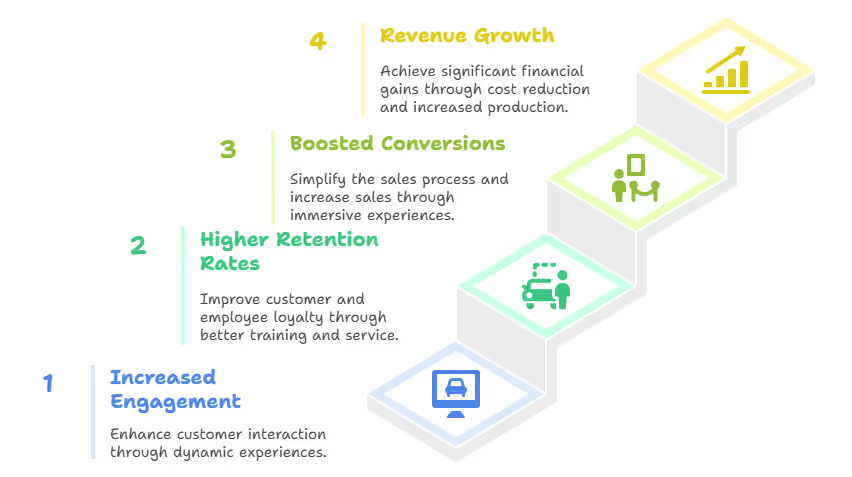
The Business Case for Augmented Reality for Automotive
So, what does this mean for your business, specifically? Beyond being cool, augmented reality for automotive solutions bring real, measurable value. They are not just tools; they spark excellent operations and help you stand out.
From the factory floor to the showroom, these technologies directly lead to better performance and a stronger position in the market.
Increased Engagement
Think about how customers connect with your brand. In today's digital age, static images and brochures just don't cut it. Augmented reality in automotive dramatically improves user interaction by making it dynamic and personal.
This level of immersive interaction isn't just fun; it builds a deeper connection.
- I recently saw a case where a luxury car brand reported a 15% increase in online inquiries after launching a virtual reality car showroom experience, proving direct engagement turning into real leads.
Higher Retention Rates
Keeping customers happy and employees skilled is crucial for long-term success. Augmented reality in automotive helps keep both users and customers longer by enhancing training and improving service experiences.
For your workforce, better training means fewer errors and more efficient work.
- When technicians can find and fix car problems with augmented reality automotive guidance, service times get shorter, and customer happiness goes up.
- This builds loyalty, making sure customers come back to your brand for future service and even their next car.
Boosted Conversions
Ultimately, every business aims for more sign-ups, more sales, or more desired actions. Augmented reality automotive solutions directly contribute to boosted conversions by making the buying journey more tangible and compelling.
This reduces friction in the sales funnel.
- By letting customers truly see their dream car before ever going to a dealership, you help them make confident choices.
- This leads to higher conversion rates and a simpler sales process.
Revenue Growth
Connecting AR/VR to real money results is where it truly matters. Augmented reality in automotive contributes to significant revenue growth through various channels. By needing fewer expensive physical prototypes, you cut development costs.
By making manufacturing faster and reducing errors, you increase how much you produce and how quickly products reach the market.
- Remember that European car maker I talked about? Their new hires, using AR guides, reached expert-level assembly speeds 40% faster than those trained the old way.
- That directly impacts how much you produce and, in turn, your income.
Power of Augmented Reality for Automotive Design and Engineering
Let's start where every great car begins: the design stage. Or, more exactly, the digital design studio. The early steps of vehicle making are perfect for AR. Honestly, the days of only using very costly physical models or flat, boring 2D screens for design checks? They are becoming a thing of the past.
My own work has shown me again and again that augmented reality for automotive design teams greatly cut down how long it takes to make changes.
It also greatly improves how teams work together and make choices.
This directly means faster product cycles and, very importantly, more new car ideas reaching the market.
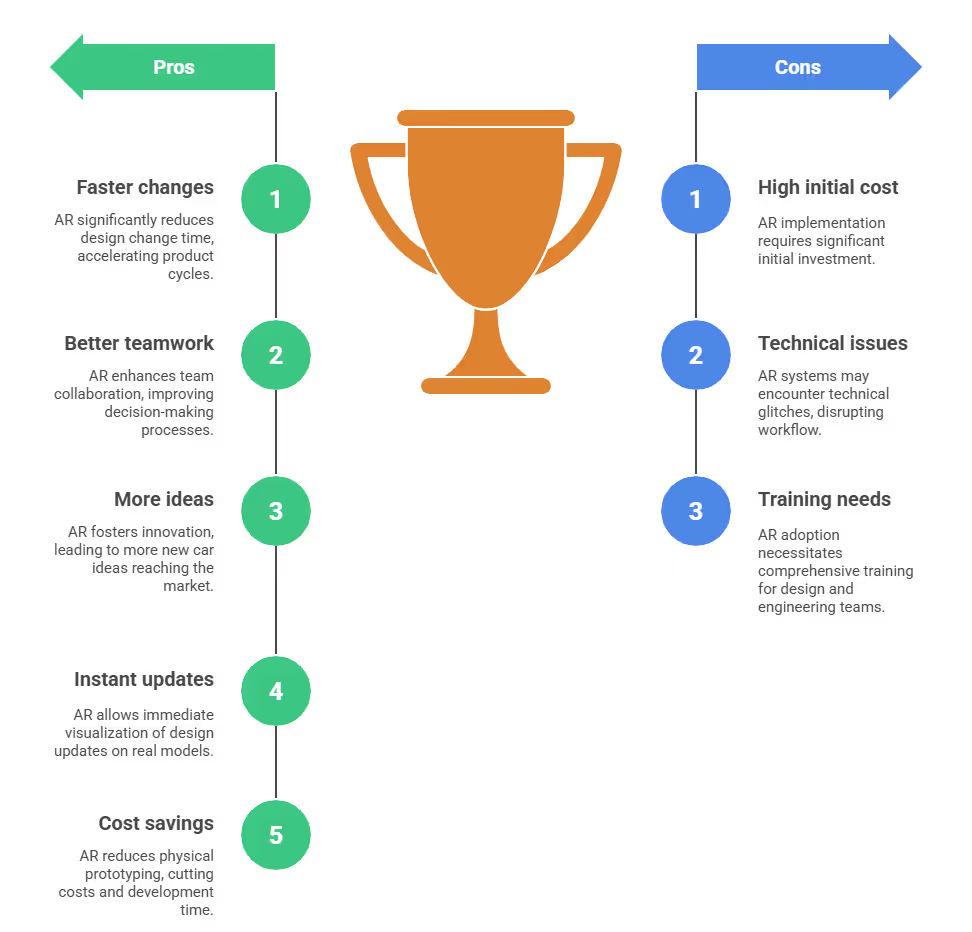
Accelerating Design Iteration with AR Overlays
Imagine this situation: you have designers in Tokyo, engineers in Stuttgart, and marketing leaders in California, all needing to check a new car idea at the same time. With AR, they can. They can place detailed digital 3D models onto real spaces – maybe an existing car frame in a design studio, or even just an empty room.
This allows for instant changes and seeing updates right away.
- For instance, a designer in Germany can immediately see how a small change to a fender looks on a real model in a Detroit lab, all while talking about it live with colleagues. This capability is incredibly powerful, especially for complex components where understanding spatial relationships is paramount.
- I've personally seen projects where design review times plummeted by over 30% just by adopting these AR methods.
- It's like having a magic lens that shows you the future of your design, right now.
- This makes the design process much faster and more accurate.
Enhancing Prototyping and Simulation with Augmented Reality in Automotive
Now, while virtual reality offers fully immersive, digital-only simulations, augmented reality in automotive prototyping gives you the best of both worlds – a powerful mix. Engineers can project digital parts onto real prototypes. This means they can test how parts fit, look, and work without the huge cost and time of changing physical models. Does this help find ergonomic problems? Absolutely.
Can you check how well a driver can see with a new dashboard layout? You bet. Can you even pretend to see airflow around new body panels before they are even made? Yes! This practical use of ar in automotive isn't just about saving money; it's about finding possible problems much, much earlier in the development process.
We are talking about finding issues long before mass production even starts.
- For example, a new dashboard design can be shown on a physical model, letting engineers test how easy it is to reach and see controls.
- This makes sure the driver interacts with the car in the best way.
- This greatly reduces the need for many physical prototypes, cutting costs and accelerating the entire development pipeline.
The Automotive AR and VR Market: Reshaping Sales and Customer Experience
Beyond the factory walls, the way you connect with your customers is also undergoing a massive transformation.
The automotive AR and VR market is booming, driven by a powerful desire to create more engaging and personalized experiences for potential buyers.
This shift allows customers to interact with vehicles in ways they never could before, directly driving sales and fostering deep brand loyalty.
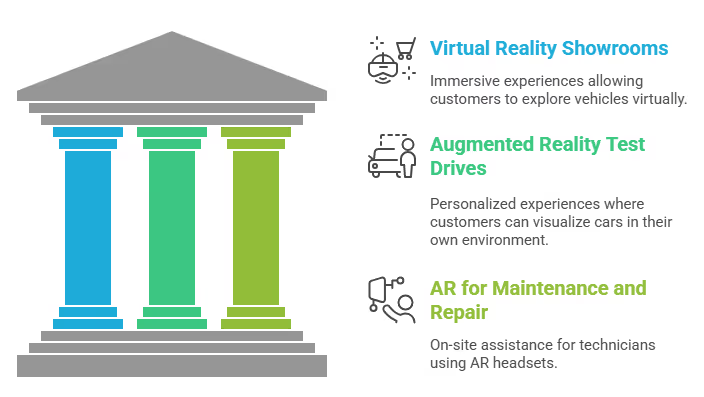
Virtual Reality Car Showroom: A New Paradigm for Sales
The idea of a virtual reality car showroom isn't some futuristic dream anymore; it's happening now. Think about it: customers can look at a car's inside and outside in a fully immersive VR setting. They can change colors, trims, and features with just a few clicks.
This is particularly beneficial for dealerships with limited physical space or for showing rare, high-end, or even concept cars that are not physically there.
It lets customers "test drive" a car virtually, experiencing different driving conditions or even seeing how it performs.
This powerful use of VR in automotive industry completely removes limits of distance, giving your sales a truly global reach.
- I recently saw a case where a luxury car brand saw a 15% increase in online inquiries after launching a VR showroom experience.
- This proves its direct impact on getting new leads.
- This is a clear sign of the growing virtual reality in automotive market.
Augmented Reality for Personalized Test Drives and Configurations
Now, let's talk about something even more personal. Imagine a potential buyer standing in their own driveway. Through their smartphone or a light AR headset, a full-size digital model of their dream car appears. It looks perfectly real and is the right size.
They can walk around it, open the doors, change colors, and even see how it looks parked right in their own garage.
This is augmented reality automotive in action, offering an incredibly personalized pre-purchase experience.
Dealerships are leveraging this to allow customers to configure vehicles at home, reducing the need for many physical models on the lot.
This seamless integration of digital and physical worlds is an incredibly powerful sales tool.
- A potential buyer can see how a new SUV fits into their existing garage or how a specific paint color looks under their home's natural light.
- This makes the decision to buy feel much more real and confident.
- This is a key part of the augmented reality automotive market expansion.
Post-Sales Support and Maintenance with Augmented Reality in Automotive
The usefulness of AR does not stop once the car is sold. For maintenance and repair, augmented reality in automotive provides technicians with invaluable, on-the-spot help.
An AR headset can show diagnostic information, step-by-step repair instructions, or even highlight specific parts that need attention directly on the engine or inside the car. This dramatically reduces repair times. It also improves finding problems more accurately.
And here's the best part: it helps less experienced technicians do complex tasks with confidence.
This is a key area where AR VR in automotive industry offers huge gains in how well things work.
- For example, a technician trying to fix a tricky electrical problem can see a digital picture of the wiring diagram directly on the real engine. This guides them to the exact broken part. This lowers mistakes in finding problems and makes service faster, ultimately making your customers happier.
The Broader Impact of VR in Automotive Industry: Training, Safety, and Beyond
While AR often gets the main attention for showing digital things over the real world, let's not forget that virtual reality in automotive industry plays a very important role too.
This is particularly true in areas like training, safety simulations, and even the very new development of self-driving cars.
Its deeply immersive nature makes it the perfect tool for situations where real-world practice is too dangerous, too expensive, or just not practical.
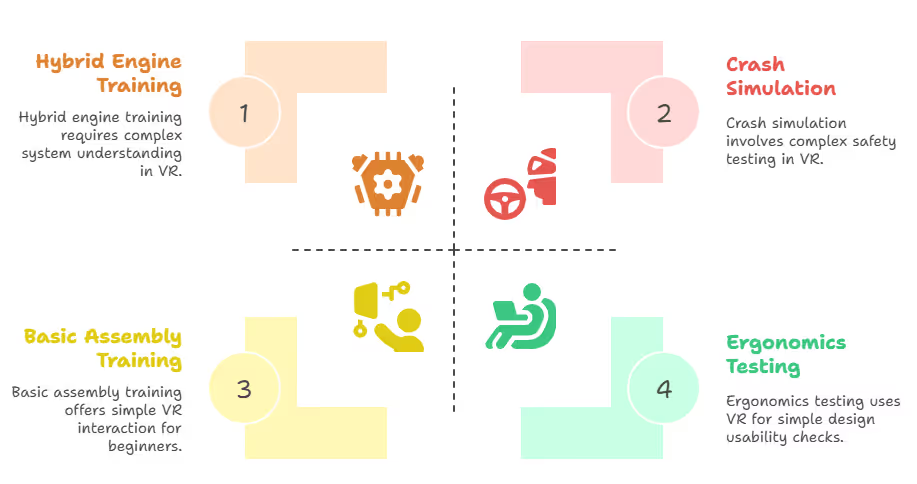
Immersive Training for Complex Systems with Automotive VR for Training
Beyond just training for assembly lines, automotive VR for training is changing how technicians and engineers learn about complex car systems. Instead of dry, abstract drawings, VR allows truly hands-on, simulated interaction with engines, complex electrical systems, or advanced driver-assistance systems (ADAS).
Trainees can virtually take apart and put back together parts. They practice finding problems.
They fix issues in a completely safe environment.
This leads to much better learning and a more skilled workforce.
This is incredibly important given how modern cars are becoming more and more complex.
- For instance, a new engineer can learn the details of a hybrid engine in a virtual world. They can practice repairs and finding problems without risking damage to a real car.
- This makes learning skills faster and reduces the need for expensive physical training models, a win-win for everyone.
Safety Simulations and Ergonomics with Virtual Reality in Automotive
VR is an unmatched tool for pretending dangerous situations or carefully testing how designs feel to use. Car engineers can use VR to check how well a driver can see. They test where controls are best placed. They can even pretend to have car crashes from the driver's view.
They can do all of this without building a single real prototype.
This vital use of virtual reality in automotive is absolutely key for making cars safer and more comfortable to use.
It allows for quick changes and improvements, meaning safer and easier-to-use cars reach the road faster.
- Imagine pretending various crash situations to check passenger safety or testing the best spot for entertainment controls to keep the driver from getting distracted.
- VR provides a controlled, repeatable place for these important checks, leading to safer and more user-friendly cars for everyone.
- This is a crucial part of the virtual reality automotive industry.
Augmented Reality for Automotive Market: Challenges and Opportunities
The fast growth of the automotive augmented reality market and the larger automotive augmented reality and virtual reality market brings both exciting chances and some very real challenges.
As an AR/VR developer, I've observed several key things for industry leaders like you to think about.
Dealing with these challenges well will directly decide how successful AR/VR adoption is within your company.
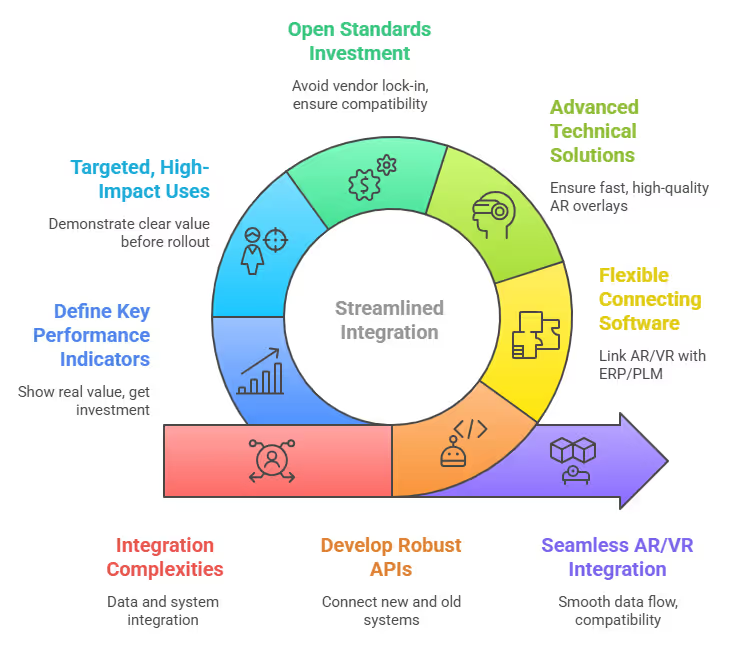
Integration Complexities and Data Management
Let's be honest: putting AR/VR solutions into your existing car systems is not easy. It needs strong ways to move data. It needs smooth work with your current CAD/CAM systems.
And it needs very good management of huge 3D data sets.
Making sure AR overlays are fast and high-quality, especially in busy factory settings, needs advanced technical solutions.
- Car companies often deal with huge amounts of data and old systems. This makes smooth integration a big hurdle.
- Making strong APIs and flexible connecting software is very important to link new AR/VR platforms with your existing business planning (ERP) and product management (PLM) systems.
- It's a puzzle, but one that brings huge rewards once solved.
Hardware Evolution and Standardization in the Automotive AR and VR Market
The look and abilities of AR/VR hardware are always changing. While headsets are becoming more comfortable, powerful, and easy to get, making them work the same across different systems is still a challenge.
Car companies need to think long-term here: consider how to grow and stay ready for the future when buying specific hardware.
- The quick pace of hardware changes means you must pick flexible solutions that can adapt to future improvements. Investing in open standards and platforms can help avoid being stuck with one vendor and ensure long-term compatibility.
- It's about making smart, forward-thinking investments in the automotive AR and VR market.
ROI Justification and Scalability for Augmented Reality Automotive Market
For car industry leaders, the main goal is always ROI – return on investment. While the benefits of AR/VR are becoming clearer, figuring out their exact value and growing small projects to full production needs careful planning and a deep understanding of what the technology can and cannot do.
My experience always suggests starting with targeted, high-impact uses.
This lets you show clear, undeniable value before doing a bigger rollout.
- Clearly defining key goals (KPIs) for your AR/VR use, like fewer mistakes, faster training times, or more sales, is vital for showing real value and getting more money to invest.
- Show the wins, then grow.
- This is key for the augmented reality automotive market.
Comparative Overview: AR vs. VR Applications in Automotive
To give you a clearer picture, here's a quick summary of how AR and VR are typically used in the automotive sector.
They're distinct tools, but they often complement each other beautifully.
The Road Ahead for Augmented Reality in the Automotive Industry
The automotive augmented reality and virtual reality market is clearly growing fast. This growth comes from very real benefits: better efficiency, big cost savings, and much improved experiences for users.
For car industry leaders like you, the way forward is clear: use these technologies smartly. Don't try to do everything at once. Start with smart, focused small projects that fix specific problems. Measure your return on investment very carefully. And most importantly, create a culture of new ideas within your company that truly uses the special abilities of AR and VR.
The future of cars is definitely immersive, and those who step up to lead this change will be the ones who define the next generation of mobility.
Ready to find out how augmented reality automotive solutions can truly transform your operations?
Don't wait. Talk to AR/VR experts – like myself – to plan your next steps. Let's unlock the full power of immersive technology for your enterprise, together.


